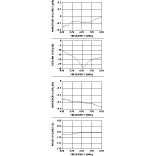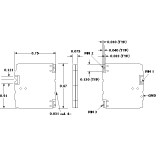A Bonding Prepreg for Microwave Multilayer PCBs That Uses FR-4 Processing
Rogers Corp., Microwave Materials Division
Chandler, AZ
As the high performance microwave market has evolved from a low volume, military-oriented market to one dominated by large, commercial wireless applications, microwave circuit boards have also undergone a fairly dramatic transformation. Simple microstrip and stripline circuit designs based on polytetrafluoroethylene (PTFE) laminates have had to adjust to meet the cost and volume demands of today’s market. In the past, the lowest loss material won the race, but the new demands of the commercial market are much different from the traditional military requirements. Instead of focusing on loss only, today’s wireless designers are looking for a microwave laminate system with characteristics that are much different.
The traditional PTFE circuit board requirements focused almost exclusively on the electrical properties of the laminate core itself. Little attention was given to the bonding prepreg due to the relatively straightforward microstrip designs that composed a majority of the requirements. Stripline designs utilized a variety of thermoplastic bond films to achieve a reasonable bond between layers. However, due to the relatively high process temperatures needed to melt these films, only a few specialty fabrication shops were capable of supporting this activity. Meanwhile, mainstream low frequency circuit manufacturers were using glass-epoxy FR-4 material systems consisting of a laminate core material and a B-stage of the same resin system to achieve homogeneous multilayer circuit board construction in a flexible, cost-effective manner.
Today, wireless equipment designers are seeking the best of both worlds: a high performance, low cost laminate system that is fabricated similar to FR-4. The type RO4003™ ceramic-filled, thermoset resin-based laminate was introduced in 1996 as an answer to this need. The material provides good electrical and mechanical performance (superior to PTFE-based laminates in some cases) while offering the low cost, high volume fabrication properties of FR-4 materials. Soon after this laminate was introduced, the type RO4350 laminate material was designed, which added fire-retardant properties while maintaining a dielectric constant of 3.48 and a loss tangent of 0.004. In addition, both materials feature excellent via reliability by virtue of their 50 ppm/°C coefficient of thermal expansion (CTE) in the z-axis, a value far superior to that found in traditional PTFE woven-glass laminates. Figures 1 and 2 show the material’s dielectric constant vs. frequency and z-axis CTE, respectively, as compared to PTFE/woven glass. Thus far, both the RO4003 and RO4350 laminates have proven to be very popular for use in new commercial high frequency applications.

A Compatible Bonding Prepreg
The newest emphasis is on microwave and hybrid multilayer PCBs, and the missing link to complete the RO4000 series laminate system has been the bonding prepreg or B-stage. Designers using the newest laminates for multilayer construction have been forced to choose between low cost, low performance epoxy-based prepregs or very high cost, high performance blended materials. Until now, no overall best choice was available.
The new type RO4320 bonding prepreg is the proverbial best choice for high performance, low cost multilayer microwave PCB fabrication. This new bonding material is specifically designed for use with RO4000 series laminates and features a dielectric constant of 3.2 and a loss tangent of 0.004. The material is a no-flow prepreg with a post-cure glass transition temperature greater than 280°C and is initially offered in a 0.004"-ply thickness. The bonding material is also expected to pass a UL 94V-0 flammability rating.
The new prepreg material has been designed specifically to have a bond cycle that is compatible with typical FR-4 types. Along with its ability to bond at 375°F, the RO4320 prepreg can be processed using standard FR-4 processing techniques.
In fact, hybrid constructions, or circuits that combine RO4000 series materials with FR-4 materials, may be bonded during a single lamination cycle instead of the two cycles required previously in other hybrid constructions that combine PTFE-based materials with FR-4. A huge cost savings can be realized using this approach. At last, designers can develop high performance, homogeneous multilayer circuits that can be produced economically by almost any PCB fabricator. Since most FR-4-type shops can easily fabricate PCBs using RO4000 series materials, designers now have fabrication flexibility, which can lead to quicker product cycle times and more cost-competitive fabricated circuits.
Multilayer PCBs fabricated with the RO4000 series laminate system may be processed through conventional FR-4-type plating, drilling and bonding operations with little modification. One or more layers of RO4000 series laminates may be integrated easily into conventional multilayer PCB designs to dramatically improve high frequency performance with no change to the fabrication process.
Prepreg Processing
As stated previously, the RO4320 prepreg material has been designed specifically to complement the RO4003 and RO4350 laminates in multilayer structures. The material is shipped in heat-sealed bags and slip sheeting is provided to ease separation of the individual plies. Tooling holes may be punched, drilled or cut in the material and the slip sheeting should remain in place during these operations. Each individual prepreg ply adds 0.004" to the multilayer assembly’s thickness when the inner layers being bonded are copper or fully etched dielectric planes. The final assembly’s thickness depends on the distribution and thickness of the metal layers being bonded.
The RO4320 prepreg fully cures in an FR-4-like bond cycle that includes a 60-minute minimum dwell at 360° to 375°F (182° to 190°C). The ramp up to the bonding temperature may be slow (4°F/min) or rapid (12°F/min). Cooling can be accomplished in the heating press at a controlled rate or accelerated using a cold press.
A bonding pressure of 300 psi is adequate for most designs. The pressure may be increased to 400 to 500 psi to fill moderately sized blind vias. Vacuum assistance is recommended, but not necessary. A bonding pressure of 300 psi results in the fill of 4 mil spaces in 1 oz copper.
Conclusion
The combination of low temperature bonding and high post-cure glass transitions makes the RO4320 prepreg and RO4000 series laminates a good choice for microwave and hybrid high volume, low cost, multilayer PCBs, including blind via designs requiring sequential laminations. The combination will not thermally degrade through multiple bonding cycles. Samples of the RO4320 prepreg material are available currently for evaluation.
Rogers Corp.,
Microwave Materials Division,
Chandler, AZ (602) 961-1382.
